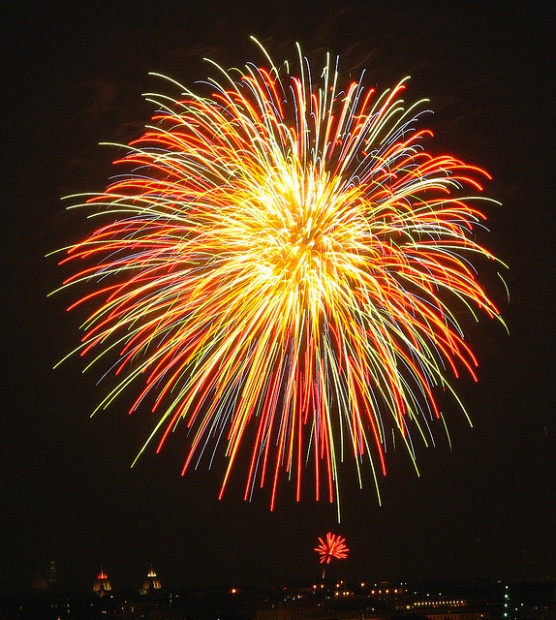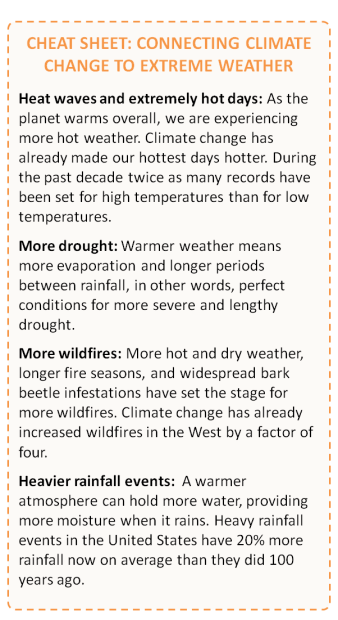We have much more to do and your continued support is needed now more than ever.
Talking Climate Change before the Fireworks

As we marvel about these events, it’s important to also point out that this sort of weather on steroids is exactly what we expect from climate change. Some of the leading news outlets are starting to do just that (see the Washington Post for example), a welcome development from even just a couple weeks ago.
Now, we all need to step up make those same connections for our family and friends. When the talk at our picnics turns to weather this Fourth of July, let’s all make a conscious effort to turn the talk to climate change. Here are some tips for how to approach that conversation:
Connect the dots
One challenge in having these sorts of conversations is that we have to make the links between several different parts of the story: carbon pollution, climate change, extreme weather, communities, nature, and the bottom line. It’s not always possible to tell the full story in the time it takes to finish your macaroni salad! So focus on making some of the key connections, such as:
- Stick to science basics. Even if folks suspect that many weather and climate extremes of late are outside the norm, they might not understand what’s causing the changes. Yet, the logic behind why a warmer planet leads to more weather extremes is pretty straightforward. Check out our cheat sheet below for some quick explanations.
- Remind folks about other recent extremes. Turns out that people are pretty bad at remembering past weather events and putting current ones in context. It’s a good idea to jog people’s memories about extreme events that happened in previous seasons or years, connecting the current spate of events with the longer-term patterns. Do you remember the major flooding in the Northeast US from back-to-back storms at the end of last summer? Or what about the record-setting heat, drought, and wildfires across Texas?
- Make it about the lives impacted – both people and wildlife. Climate change is having real impacts on people and wildlife today, and the costs are already adding up. The wildfires in Colorado have already cost about $40 million to fight, not to mention the much larger losses to property yet to be tallied. The derecho storm that swept across the nation claimed at least 22 lives. The wildfires in New Mexico are putting threatened Gila Trout at risk, forcing wildlife managers to manually trap and move them to unaffected rivers.
 I’m actually running out of adjectives to convey how dramatic these events are one after another. The danger is that, at some point, we can become numb to all of these losses. A major challenge in talking to our friends and family is to make the case that climate change is a real and rightfully scary prospect, and then to provide hope by turning to what we as Americans can do to lead the world in solving it.
I’m actually running out of adjectives to convey how dramatic these events are one after another. The danger is that, at some point, we can become numb to all of these losses. A major challenge in talking to our friends and family is to make the case that climate change is a real and rightfully scary prospect, and then to provide hope by turning to what we as Americans can do to lead the world in solving it.
Global Problems, American Leadership
On the Fourth, many of us take a moment to reflect on what it means to be an American, what are the values that define us as a nation. For me, America is about fighting for fairness and equity, being bold and innovative, pushing to explore new frontiers, and being self-reliant, practical and efficient. It is about being a champion of the little guy and defending against tyranny, using science and technology to achieve success and material comfort, and not least a love and appreciation for the natural beauty of our country.
Tackling climate change means embracing these very same values. It means harnessing American innovation to push the frontiers of new, clean energy development. It means communities looking for ways to be more resilient in the face of more extremes and in how they get their energy. It means recognizing that our actions today have irreversible consequences for our children and grandchildren, and it is not fair to them for us to continue blithely burning fossil fuels. And, it means taking a stand to protect our nation’s land, water, and air from more aggressive exploitation of dirty fuels, especially when clean alternatives are at our doorstep!
These connections between our deeply held American values and how we confront climate change are perhaps the most important ones to make. After all, tapping into these values is what will motivate each of us and our political leaders to make the changes necessary to put our country on a pathway to climate stabilization.
Connecting to a Hopeful Vision for the Future
Tomorrow night, as I sit with my kids watching the fireworks dot the night sky, I will be hopeful that they will grow up in the America that I believe in. A place where we don’t shy away from the world’s greatest problems, but rather confront those challenges with ingenuity and optimism.
If you have the same vision, then join me in sharing it with friends and family. And let the Environmental Protection Agency know that you support strong limits on carbon pollution.





















